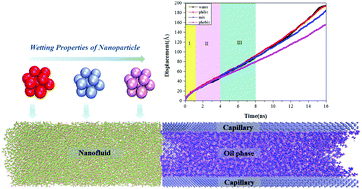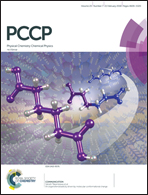Atomistic insights into the nanofluid transport through an ultra-confined capillary†
Abstract
Nanofluid or nanoparticle (NP) transport in confined channels is of great importance for many biological and industrial processes. In this study, molecular dynamics simulation has been employed to investigate the spontaneous two-phase displacement process in an ultra-confined capillary controlled by the surface wettability of NPs. The results clearly show that the presence of NPs modulates the fluid–fluid meniscus and hinders the displacement process compared with the NP-free case. From the perspective of motion behavior, hydrophilic NPs disperse in the water phase or adsorb on the capillary, while hydrophobic and mixed-wet NPs are mainly distributed in the fluid phase. The NPs dispersed into fluids tend to increase the viscosity of the fluids, while the adsorbed NPs contribute to the wettability alteration of the solid capillary. Via capillary number calculations, it is uncovered that the viscosity increase of fluids is responsible for the hindered spontaneous displacement process by hydrophobic and mixed NPs. The wettability alteration of the capillary induced by adsorbed NPs dominates the enhanced displacement in the case of hydrophilic NPs. Our findings provide guidance for modifying the rate of capillary filling and reveal the microscopic mechanism transporting NPs into porous media, which is significant to the design of NPs for target applications.



 Please wait while we load your content...
Please wait while we load your content...